Are you looking for the best compressor pedal for metal? Then, you are in the right place: we will help you make an informed decision.
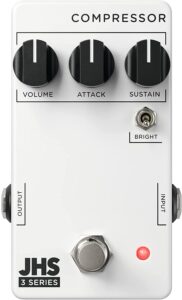
As a rock music genre, metal rooted in acid rock, psychedelic rock, and blues-rock has spawned numerous subgenres and fusion genres.
Heavy metal music, popularly called metal, can be identified by its intensity, resounding hits, extensive guitar solos, and marked distortion. Regardless of whether you play Christian metal, speed metal, doom metal, or pirate metal, sooner or later you’ll feel the need for a compressor pedal besides a versatile distortion pedal.
Though delay, overdrive, distortion, and fuzz pedals take precedence over compressor pedals in the metal realm, the latter is indispensable for attaining tonal illumination.
A good compressor comes in handy for boosting tonality and smoothing resonance of mid-gain tone warps and fine-tuning your instrument’s output. Compression pedals for metal help create the sweet spot between louder and quieter tones and deliver greater sustain.
Without further ado, let’s look at our list of the best compressor pedals for metal.
Best Compressor Pedals for Metal (Comparison Table)
| Image | Model | Dimensions | Price |
|---|---|---|---|
 | JHS Pedals 3 Series Compressor (Top Pick) | 4 x 3 x 2 | Check Price |
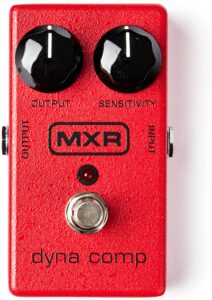 | MXR M102 Dyna Comp Pedal (Best on a Budget) | 5.8 x 4.5 x 2.8 | Check Price |
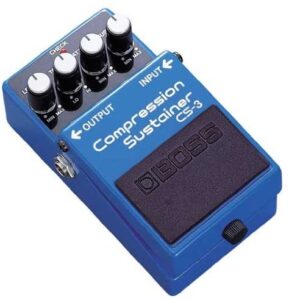 | Boss CS-3 Compressor Pedal (Close Runner-Up) | 4 x 3 x 6 | Check Price |
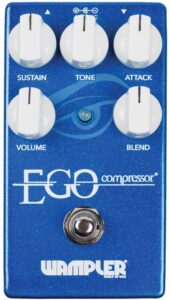 | Wampler Ego V2 Pedal | 7 x 4 x 7 | Check Price |
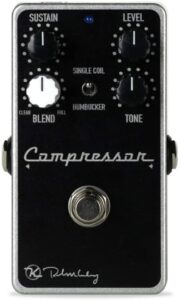 | Keeley Compressor Plus Pedal | 6.75 x 4.25 x 3.25 | Check Price |
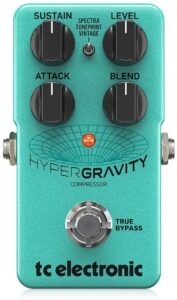 | TC Electronics EQ Effects Pedal | 5 x 3 x 4 | Check Price |
1. JHS Pedals 3 Series Compressor (Editor’s Choice)
The JHS Pedals 3 Series pedals from JHS is a group of highly versatile yet supremely affordable compressors that are incredibly performance-driven. Every compressor pedal has been crafted employing premium components, efficient allocation of resources, and maintaining stringent quality control. This Series 3 pedal features three straightforward control knobs and a switch offering a wide gamut of tones for professionals and amateurs.
You can’t go wrong with the JHS Pedals 3 Series when it comes to experimenting with new sounds and taking your playing style to the next level. This pedal helps deliver anything from evened out delicate tone to an ultra compressed sound and everything in between. In addition, you can use the ‘sustain’ and ‘attack’ controls for dialing in your customized compression with the right level of response.
And the volume knob comes to your aid when you need to adjust the overall volume, either setting it at unity or enhancing it. And if you’re looking to bring in a more vivid EQ to sustain your tone, press the ‘bright’ toggle.
Pros
- Compressor pedal housed inside a rock-solid metal case
- Very user-friendly and pedalboard-friendly: plug and play
- Compression squelches and squeezes guitar frequencies into a compacter width and balances out volume resulting in a more consistent tone
- Bright toggle for dialing in a more dynamic EQ to enable your tone to retain its magical spark
- The highly refined quality of sound owing to the state-of-the-art electronic components
- Intuitive controls for delivering a sweeping range of sounds
- Bypass footswitch
- Get smooth, soothing sound to incredibly compressed tones
- It’s perfect for playing modern metal
Cons
- Bass notes tend to become a bit muddled
2. MXR M102 Dyna Comp Pedal (Best on a Budget)
Amongst all popular compressor pedals for guitar out there, the MXR M102 Dyna Comp Pedal is perhaps the most sought-after. The user-friendliness and the simplicity of Dyna Comp make it the default compressor for many players. In addition, the M102 Dyna Comp Pedal features only two control knobs, ‘output’ and ‘sensitivity’ which makes using this compressor remarkably easy.
The ‘level’ or ‘output’ control allows you to adjust the level or degree of compressed output, while the ‘sensitivity’ helps modulates the total compression range. Instead of implanting separate knobs for setting ‘release,’ ‘attack,’ ‘ratio,’ and ‘threshold,’ MXR has kept things simple by infusing them all in one control knob.
You need to tweak the sensitivity knob for regulating ratio, threshold, release, and other guitar effects-it is that simple. The biggest benefit of having just one knob for adjusting compression is that you don’t need to determine the appropriate setting for each effect. The Dyna Comp stompbox should be there on your pedalboard if you wish to titillate your eardrums with that signature short, light metallic sound typical of a clean guitar.
MXR Dyna, introduced in 1972, slowly and gradually became a bestselling compressor due to its user-friendliness and affordability. This compressor inspired the creation of numerous adaptations and clones thanks to its vibrant compression range and its ability to balance out the volume inconsistencies between notes.
Last but not least, it’s a very inexpensive compressor pedal for metal, especially taking into account how good it is.
Pros
- Excellent and holistic sensitivity control
- Fabulous tone
- Easy dual knob function
- Consistent output signal
- Facilitates boosting of sustain with steady dynamics
- Inline compressor makes the signal to your amp even and smooth
- Nashville studio standard
- Very affordable in terms of its price – the cheapest pedal on our list.
Cons
- It does not offer adequate flexibility or control.
3. Boss CS-3 Compressor/Sustainer Pedal (Close Runner-Up)
The versatility of the Boss CS-3 Compressor/Sustainer Pedal lies in that this device enhances low-end signals and squishes louder signals. At the same time, the CS-3 furnishes uniform and soft sustain without corrupting your instrument’s natural or organic sound quality. In addition, the knob controls for level, tone, attack, and sustain on the pedal’s user interface helps in precise tonal shaping.
On the other hand, the low-noise layout goes a long way in enabling pin-drop silent operation. Possibly the simplest way to fine-tune the sound of your guitar is to use an effect pedal, and the CS-3 compressor/sustainer pedal ensures that. And when it comes to fixing issues you’re facing with sustain, the CS-3 pedal is your best bet.
Though the BOSS CS-3 costs much less than a boutique pedal, it performs like one in many ways. You get good value for money thanks to its durable and compact constructions and also for offering an abundance of tone-shaping alternatives. The CS-3 compressor/sustainer pedal comprises the 3rd generation of the Boss Compact Series (following CS-1 and CS-2), adding a tone control to the current level, attack, and sustain knobs.
An extensive gamut of effects from smothered sounds to tender compression delivered by Boss CS-3 will keep you completely enthralled. This compressor/sustainer pedal enables you to take advantage of EQ effects and operates almost silently but efficiently. The ‘level’ knob functions as the characteristic ‘compression’ control tuning your required level of effect into the sound output.
The ‘attack’ knob comes to your aid when or whenever you have to adjust or fine-tune the strumming intensity. The ‘tone knob lets you manipulate the tones reproduced or compressed by CS-3, while the ‘sustain’ knob aids in controlling the notes’ duration.
Pros
- Amplifies lower signals and squeezes or suppresses louder signals
- Balanced and smooth string response
- Extra punch and clarity with smooth sustain
- Performs perfectly on a standalone basis and also when paired with a chorus or distortion pedal
Cons
- Introduces slight buzz and hiss sounds to the signal chain
4. Wampler Ego Compressor V2 Pedal
The Ego Compressor V2 Pedal from Wampler has everything going for it, making it the perfect effect pedal to mount on your pedalboard. The Wampler Ego Compressor is an impeccable compressor that is transparent and flexible and maintains your instrument’s natural sounds. This compressor excels in bringing about the squish and compress aspect of a tube-driven amp while letting you control the effects.
If you’re looking to tweak your solos and beef up your cadences, you can use it as an ‘effect’ instead of keeping it on all the time. Allow your instrument to settle down comfortably in a muddle-up by dialing in that slight extra shimmer. The ‘sustain’ knob makes the Ego go the whole hog in tethering and keeping the signal within the compression threshold.
The tone knob is an excellent addition to the Ego Compressor V2 Pedal. When this knob is at the anticlockwise point, it does not affect the signal in any way. But as you turn the knob in the clockwise direction, you sense that the compressor gradually puts in glitter and dynamism to your sound.
Pros
- Designed with meticulous care to help retain playing dynamics without coloration of tone
- Offers unprecedented control to modern-day players
- Straddle the entire spectrum of compression effects from clean whispers to lucid screams
Cons
- Stacking up the Ego with other pedals could make it somewhat loud
- Pricey
5. Keeley Compressor Plus Pedal
The brainchild of Robert Keeley, the Keeley Compressor ‘Plus’ Pedal now comes reinforced with added features making it more versatile. The pedal retains the perceptive layout, and the addition of a release switch makes the compressor more intuitive. In addition, the release switch offers you ample scope to dial in the right amount of attack for single-coil pickups and humbuckers.
The ‘blend’ knob helps in setting your required or desired level of compression of the signal. For example, if you turn the knob a full 360° in the clockwise direction, your signal will be harsh and throaty while turning it completely anticlockwise dials in a 50% blend. The tone control greatly recouped what you lose in the form of harmonics and high-end with compression.
If you want to render your sustain melodic, buff up your tone, and balance out your sound, then choose Keeley Compressor ‘Plus.’
Pros
- Replicates the JFET rack-mount compressor’s effects and performance
- Pedal’s compact design ensures easy mounting on pedalboard without occupying a minimal footprint
- Craft your signature tunes using sustain, blend, level, tone, and release/attack controls
- Just flip a toggle for switching from a single-coil guitar to a humbucking bass
- Emulates the effects of an expensive boutique compressor pedal at half the price
Cons
- It can get a tad too noisy
6. TC Electronics EQ Effects Pedal
The Hypergravity EQ Effects Pedal is an excellent compressor with a three-way switch for upgrading your tones from mundane to sublime. The three-way toggle lets you pick and choose from ultra-lucid Spectra compression, spongier vintage compression, and an all-embracing TonePrint collection. You can’t go wrong with the TC Electronics EQ Effects Pedal when it comes to achieving your preferred tone with smooth dynamics.
The Hypergravity compressor’s technologically advanced circuitry has been impeccably engineered for applying personalized compression to your highs, midrange, and low ends. As a result, this compressor pedal stays with you as you shunt from unrestrained niche tone-holds to subtle, airy sparkle.
Pros
- The studio-grade multiband compressor pedal
- True bypass for full-on clarity with no high-end loss when pedal stays switched off
- Buffered bypass (optional) functionality for averting high-frequency loss extended cable runs
- It offers you the best of both worlds- analog and digital
Cons
- Players could be spoilt for choice owing to the availability of too many options
- The vintage and Spectra preset settings become terrible after sounding pretty pleasant initially.
Are Compressor Pedals Good for Metal?
As a heavy metal player, while developing your ideal pedalboard, you’ll have to take a call on whether you’ll be requiring a compressor. Before you can make up your mind, you’ll need to understand how the compressor pedal can effectively fit in your metal rig. Compared with other guitar effect pedals, a compressor including ‘EQ,’ ‘distortion,’ ‘overdrive,’ and ‘fuzz’ takes a back seat.
Nevertheless, compressors play a crucial role in boosting your instrument’s tonality and overall sound. Concerning your heavy metal arrangement best compressors can come to your aid in various ways.
What is the Function of a Compressor Pedal?
What does a compression pedal do for metal tones? The primary function of compressors is to compress or squeeze the loudest “metal” signals into quieter sounds and vice-versa. To put it precisely and succinctly, a compressor pedal condenses and squashes the entire dynamic range of sound in unison. Thus, the compressor squelches the dynamics, lessens the transitory range, and smoothes out the sound as a whole.
Premium compressor pedals for metal of Boss, MXR, JHS, and Wampler tend to be exceptionally effective in:
- Balancing out dynamics
- Boosting sustain
- Enhancing lower dynamics
- Alleviating assault transience
- Modulating playing volume
Making the Most of a Compressor for Metal
Do I need a compressor pedal for metal? I hear such questions all the time. Following are some excellent reasons why you should stack up a compressor with other effect pedals on your pedalboard:
Dirt-Free Crystal Clear Boost
Almost all heavy metal players especially lead guitarists, find a compressor pedal incredibly handy for enhancing lower dynamics and sustain. Unfortunately, though you’ll come across a wide variety of pedal brands that’ll help with signal boosting, many of these have unwanted downsides. For instance, as a lead player, you may not be able to construe loss of volume while playing solo tunes.
This problem tends to become pronounced when you’re performing together with other players belting out arpeggios, rhythms, and cadences. Though you can get around the issue by using a boost pedal or adding mids to your tones, these tweaks create new problems. And this is precisely where a compressor pedal comes to your rescue, offering a transparent signal boost without affecting your original soundstage.
Nevertheless, you’ll need to position the compressor on the appropriate point in the signal sequence or chain to achieve this. Compressor pedals not only help add extra vigor to your solos without bringing in distortion but also fine-tune your tone’s natural harmonics.
Adding Sustain
Another good reason for mounting and stacking up a compressor pedal with other pedals (on your pedalboard) is to accomplish cleaner sustain. A compressor is quite effective in delivering sparkling sustain making your tones stand out. The best part is that the organic sustain doesn’t append any distortion keeping your notes audible in the sound mix. So the question “what is the best compressor/sustain pedal for metal” makes even more sense than the one we put in the title 🙂
Balanced Out Sound Dynamics
Balancing the sound dynamics is the top reason jazz, blues, country, and metal players opt for compression pedals. You can look forward to diminishing your notes’ attack transience bringing about better coordination by way of volume level and attack provided the compressor is in the correct position along the signal path.
Conclusion: The Best Compressor Pedal for Metal Is…
So, what the best compressor for metal is? We need to pick now.
Apart from boosting the dynamics, transparency, sustain, and tonal quality for rock, jazz, and blues musical styles, compressor pedals also facilitate the reproduction of high-gain heftier metal tones. If you want to enhance sustain, improve lower dynamics, smooth out volume and dynamics, and tone down attack transience, go for any compressors reviewed above.
We think that the JHS 3 Series Compressor is the best compressor pedal for metal available on the market. However, other pedals from our list of the best compressors for metal are almost as good as the winner.